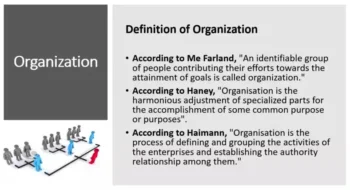Table of Contents:-
- Meaning of Organization
- Definition of Organization
- Nature of Organization
Meaning of Organization
The word organization is derived from the word ‘organism’ which means a unit with many parts and each part of it, even though working independently, has a definite relationship with the main unit. In a business, all the departments or posts have their separate functions but they are all related to the main objectives of the business.
In other words, organization means deciding about the various departments and the posts in these departments and the relationship between them. Moreover, to run their work smoothly, their authority and responsibility have to be prescribed.
Related Article:- What Are Policies
It must be made clear that the need for an organization arises only when the number of people working in an enterprise is more than one. If there is only one person, he is expected to perform all the functions single-handed and there will be no need to divide the work. In the absence of division of work, the organization is meaningless.
Definition of Organization
Different scholars have given different views about the meaning of organization:
(1) According to Me Farland, “An identifiable group of people contributing their efforts towards the attainment of goals is called organization.”
(2) According to Haney, “Organisation is the harmonious adjustment of specialized parts for the accomplishment of some common purpose or purposes”.
(3) According to Haimann, “Organisation is the process of defining and grouping the activities of the enterprises and establishing the authority relationship among them.”
A study of the above-mentioned definitions makes it clear that organization is a process of determining and grouping activities and creating formal relationships among employees of an enterprise.
Nature of Organization
There are various definitions given by different management experts and we get the following information about the nature of the organization.
(1) Common Objectives
These are various parts of an organization with different functions to perform but all move in the direction of achieving a general objective.
(2) Coordination
Under the organization, different persons are assigned different works but the aim of all these persons happens to be the same, the attainment of the objectives of the enterprise. The organization ensures that the work of all the persons depends on each other’s work even though it happens to be different.
The work of one person starts from where the work of the other person ends. The non-completion of the work of one individual affects the work of everybody. Therefore, everyone completes their work on time and does not hinder the work of others. It is thus, clear that it is like an organization to establish coordination among different works, departments, and posts in the enterprise.
(3) Division of Work
Division of work is the basis of an organization. In other words, there can be no organization with the division of work. Division of work, The entire work of an organization is divided into many departments.
The work of every department is further divided into sub-works. In this way, each person has to do the same work repeatedly which slowly makes that person an expert. Thus, under organization, an effort is made to achieve the objectives successfully by way of division of work.
(4) Authority and Responsibility
Under organisation, a chain is established between different posts right from the top to the bottom. It is specified as to what will be the responsibility and authority of every post.
Related Article:- What Are Policies
In other words, every individual working in the organization is given some authority for efficient work performance and it is also decided simultaneously as to what will be the responsibility of that person in case of unsatisfactory work performance.
(5) Plurality of Persons
An organisation is a group of many people who assemble to fulfil a common purpose. A single individual cannot create an organization.
(6) Superior-Subordinate Relationship
The relationship between a person working on different posts in the organization is decided. In other words, It is decided who will be the superior for a single post, and who will be the subordinate.
In top-level posts and bottom-level posts, every single person is somebody’s superior and somebody’s subordinate. The person working on the top level has no superior and the person working on the lowest level has no subordinate.
(7) Organisation is a Machine of Management
An organisation is considered to be a machine of management because the efficiency of all functions depends on an effective community. In the absence of an institution, no function can be performed in a planned manner.
It is appropriate to call an organisation a machine of management from another point of view. It is that machine in which no part can afford to be ill-fitting or non-functional. In other words, if the division of work is not done properly or posts are not created correctly the whole system of management collapses.

You May Also Like:-
Nature of Organisational Behaviour
Conceptual Foundation of Organisational Behaviour
Contributing Disciplines to organisational behaviour
Models of Organisational Behaviour
Approaches of Organisational Behaviour
Emotional Intelligence in Organisational behaviour
Factors Influencing Perception
Scope of Organisational Behaviour
Importance of Organisational Behaviour
Challenges and Opportunities of Organisational Behaviour
Factors affecting group behaviour
Causes of Conflict in an Organisation
Types of Conflict in an Organisation
Organisational Development Process
Factors Affecting Organisational Culture
Trait Theory: Stogdill’s trait factors
